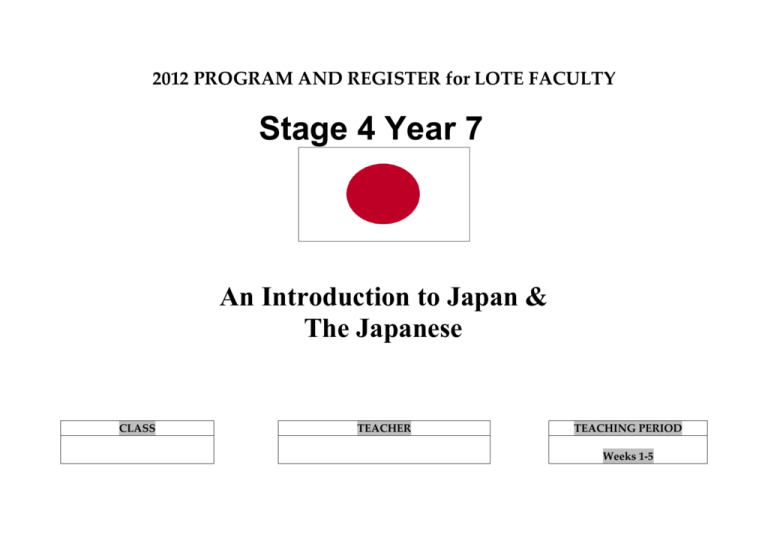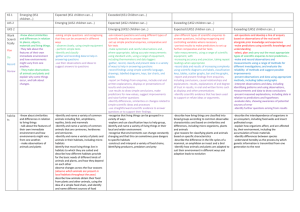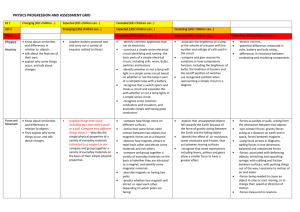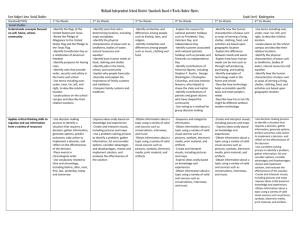File - Japanese Teaching Ideas
advertisement

2012 PROGRAM AND REGISTER for LOTE FACULTY Stage 4 Year 7 An Introduction to Japan & The Japanese CLASS TEACHER TEACHING PERIOD Weeks 1-5 UNIT OF WORK: Stage 4 – Year 7 – Term 1 – Japanese – An Introduction to Japan & the Japanese Unit Outline Unit Duration Introduction to Japan and the culture of its people 5 weeks (Weeks 1-5) Syllabus Outcomes Objectives – Using Languages (UL), Making Linguistic Connections (MLC), Moving Between Cultures (MBC) 4.MLC.1 demonstrates understanding of the importance of appropriate use of language in diverse contexts 4.MBC.1 demonstrates understanding of the interdependence of language and culture 4.MBC.2 demonstrates knowledge of key features of the culture of Japanese-speaking communities. 4.UL.1 demonstrates understanding of the main ideas and supporting detail in spoken texts and responds appropriately 4.UL.2 demonstrates understanding of the main ideas and supporting detail in written texts and responds appropriately 4.UL.3 establishes and maintains communication in familiar situations 4.UL.4 applies a range of linguistic structures to express own ideas in writing Why does this learning matter? Cross-Curriculum Content ICT, Civics and Citizenship, Difference and Diversity, Gender, Literacy, Multiculturalism, Environmental Education , Literacy Numeracy Identifying of information through Counting 1-100 comprehension and cloze passages. ASSESSMENT Cumulative homework (15%) This unit is designed to develop students’ appreciation and understanding of learning another language. It will cover reasons for learning another language, why learn Japanese, the importance of a relationship with Asia and a brief introduction of the geography of Japan and the culture of its people. Tasks and activities come from a variety of sources including textbooks, workbooks and digital programs. It is fundamental to language learning that students develop four skills – reading, writing, listening and speaking. Catering for students at all levels has been considered. Some tasks and activities will be adjusted to suit the needs of individual students. Some students will require more challenging work than the majority of the class and some students will require less challenging work. Moving the middle to the top ICT Internet resources (Google Earth & Maps), SmartBoard activities Resources Worksheets/booklets Flashcards Posters SmartBoard activities Students Learn About (throughout unit) Students Learn To (throughout unit) -the importance of prior knowledge in interpreting meaning in text -deduce meaning from context and prior knowledge of subject matter when listening for main ideas and when reading for gist -identify roles of and relationships between participants in text -the importance of understanding the intention of the speaker/s and the context in interpreting meaning -identify the purpose of texts and distinguish between the main ideas and supporting detail -identify specific information, eg by identifying statements as true or false, answering questions in English or Japanese, choosing the correct word -ways to analyse text structure and locate relevant information in texts -skim and scan text to predict meaning -linguistic features of texts, such as conversations, interviews, messages, descriptions, narratives & correspondence -initiate an interaction, eg by greeting, asking a question, interjecting -the structures and features of specific text types in order to interpret key features of the text -maintain social interactions and communicate appropriately in familiar contexts, eg turn-taking, agreeing, acknowledging, replying, and asking for repetition or clarification -the purpose and context of communication and their influence on the choice of structure -select and incorporate modelled structures when producing own texts -conclude an interaction using verbal cues and leave taking -verbal and non-verbal links with a conversational partner -produce original text using ICTs -manipulation of known structures for speaking and writing in new contexts -ways of showing that the purpose of communication has been achieved -plan, draft and edit when constructing own text -use available resources to access structures and vocabulary to build a message -the use of ICT for communicative purposes -express ideas and provide additional details in a series of linked sentences, eg using connectives -accessing resources and the organisation of relevant structures and vocabulary when planning and constructing text -recognise linguistic choices made according to purpose, eg to instruct, request, suggest -the importance of the logical development of ideas in constructing text -identify ways in which texts vary according to their intended audience, eg informality, tone of voice -appropriate choices made to achieve communication goals -recognise that grammatical concepts serve particular functions and represent part of the systems of languages -the importance of recognising audience in communication -explore grammatical systems to appreciate how languages work, eg identify grammatical terms, word order, tenses -specific grammatical concepts that operate across languages -identify ways in which stress, intonation and body language are used to convey meaning -recognise that some words and concepts cannot be literally translated -metalanguage to describe the structures and features of language -identify specific characteristics of the language, eg grammatical structures and features -ways to support effective communication -develop strategies for internalising new language and building on prior knowledge, eg mnemonic devices and communicative activities -culture-specific expressions -identify ways in which words can be written such as hiragana, katakana and kanji -specific patterns and rules in word construction, word order and sentence structure -recognise that there are culturally appropriate expressions for particular contexts -ways of conceptualising and representing patterns and systems in language -recognise how culturally appropriate language and behaviour are used in formal and informal contexts -diverse aspects of the writing system -recognise the importance of culture and cultural awareness in learning a language -identify actions, and words and phrases in the language that encapsulate aspects of culture -the significance of cultural awareness in language use and the influence of cultural values on how meaning is conveyed -identify and explain features of traditional and contemporary lifestyle -identify generalisations about people and culture eg questioning stereotypes -key features of social interactions in diverse contexts -research and present information on Japanese-speaking communities using a range of ICTs -ways of identifying cultural values and practices in observing social interaction among members of the community -ways in which language and behaviour reflect important aspects of the culture -the importance of tradition to a sense of cultural identity and diversity within the culture -representa tions of the culture of Japanese speaking communities in text, film and mass media -collecting and interpreting electronic information, with consideration of its ethical use, in order to identify and reflect on representations of culture Integrated learning experiences, instruction and assessment Evidence of learning Quality Teaching WEEK 1: -Students create title page in exercise books (discuss with students the need to have one book throughout the entire year) Student selfregulation, High expectations, -Teacher discusses & writes class rules on board & students write in books -Class discussion “why learn another language”/Teacher directed answers from Smartboard. Online websites. Students to create a group mind map/or group discussion with group leader to report back to class Students have a healthy appreciation of the benefits of learning a LOTE Substantive communication Connectedness -Students label a blank map of the world & mark continents & oceans, concentrating on the location of Asia. Differentiate the difference between the northern and southern hemisphere and locate Australia & Japan Students can identify & mark the location of Asia, Australia & Japan Cultural knowledge Background knowledge Cross curriculum - Class discussion “why is Asia an important neighbour”/Teacher directed answers Students understand the importance of Asia to Australia Students know the number of islands in Japan, its Capital & important landmarks. Substantive communication -Students label blank map of Japan (from SmartBoard) with main islands, cities, landmarks & surrounding oceans Students to research Word Heritiage sites for homework Cultural knowledge Student self-regulation Register - Students attempt “how much do you know about Japan” quiz Cultural/background knowledge -Students read short comprehension & answer questions on Japan (geography and people) Pop quiz at end of unit -Introduce four writing systems of Japanese Examples of all and allow students to practice each type of script Worksheet Students ability to identify the difference between the four scripts -Students learn how to write and say their name in Japanese (roomaji only) Introduce Katakana chart and have students devise their own name in syllables. Students ability to remember how to say and write their name in Japanese Week 2 -Basic Greeting/Expressions: Hello (in person & on telephone), Good morning, Good evening, Good night, Goodbye, See you later, Please, Thank you, Excuse me -Students write expressions in books in Roomaji -Speaking Activity: Students practice expressions in pairs -Expressions find-a-word & crossword worksheets - Listening activity – students to listen to native speaker CD and answer accompanying worksheet (Hai 1) Listening quiz Term 2 -Teacher roams class to ensure students are speaking Japanese Teacher monitors students expression, pronunciation & intonation Explicit quality criteria Cultural knowledge Metalanguage Substantive communication Explicit quality criteria Some students will struggle with Students to be introduced to Hiragana script and begin learning of the lines. Hand out entire chart and worksheets. Flashcards & writing booklets Around-the-world-game To be continued throughout the year listening skills (visual learners) whereas others will excel (aural learners) Weekly quizzes Metalanguage -Introduce Japanese festivals and the importance of them across the calander year Culture activity – seijin no hi Cultural knowledge Week 3 -Counting system: Students learn how to count from 1-10, including Roomaji & Kanji symbols -Around-the-world-game -Banzai -Worksheets - Number creation (tens and units columns) - Numbers 10-50 -Numbers 50-100 Culture activity - Setsubun Week 4 Ogenki desu ka. Introduce students to grammar of how are you? -Various responses: genki desu Ma ma desu Chotto Kibun Combine this grammar with greetings to begin Students can identify and recite the numbers 1-100, from any given pattern Numeracy Metalanguage Cross Curriculum Cultural knowledge Metalanguage conversation structure. Culture activity – computer research exercise. (edmodo?) Research given places in Japan Assessment Task Culture Quiz 20% Students can give information on a city in Japan ICT Week 5 Students learn how to ask for and give their name to somebody. -Onamae wa nan desu ka _________ desu Metalanguage Hai 1 – Listening & speaking activities Watashi/Boku no namae wa _________ desu. The ability to introduce their friends. Kochira wa ________ desu Culture activity – Homework Task: Japan: islands and cities word search (cumulative mark across semester – 20%) Cultural knowledge EVALUATION OF UNIT Teacher Evaluation How did the unit ‘rate’ in these areas? Time allocated for topic Student understanding of content Comments After you have taught the unit of work, record in this section your evaluation of the unit and any variations you implemented or would choose to implement the next time you teach the unit. Opportunities for student reflection on learning Suitability of resources Variety of teaching strategies Integration of Quality Teaching strategies Integration of ICTs Literacy strategies used Numeracy strategies used Literacy targets addressed Numeracy targets addressed Teacher’s signature: Date: Head Teacher’s signature: Date: Supervisor’s signature: Date:










